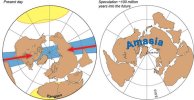http://physicsworld.com/cws/article/news/2012/feb/08/how-supercontinents-are-born
How supercontinents are born
Feb 8, 2012
James Lloyd is a science writer based in the UK
Geophysicists in the US believe they have finally solved the riddle of how supercontinents form. According to their model, each supercontinent assembles within the "Ring of Fire "subduction zone located 90° from the previous supercontinent. Projecting this into the future, the next supercontinent is forecast to be "Amasia" – a merger of the Americas and Asia.
The supercontinent cycle
The collision of continents into one huge landmass – and their subsequent drifting apart – is thought to follow a cycle of 300–500 million years. The last supercontinent, Pangaea, began to disintegrate about 200 million years ago, and a new supercontinent is expected to form in the future. Two competing hypotheses have previously been put forward to explain how this will happen.
One hypothesis says that the continents will continue to drift apart as they do today, with the Atlantic Ocean continuing to widen – eventually bringing together North America and Asia. In this "extroversion model", the new supercontinent is an "inside out" version of Pangaea situated on the opposite side of the globe to its predecessor.
Alternatively, the continents may at some point perform a U-turn and drift back towards their starting position. This hypothesis – the "introversion model" – relies on new subduction zones opening up that would allow the Atlantic oceanic crust to sink back beneath the continents. This would close off the Atlantic Ocean, forming a new supercontinent in the same location as Pangaea.
Third time lucky
However, neither of these models successfully explains all of the features of bygone supercontinent transitions. Now, geophysicists at Yale University have developed a third model, which they say provides a better fit to past data.
In their "orthoversion model", after a supercontinent breaks up, the continents initially drift apart but become trapped within a north–south band of subduction – a relic of the previous supercontinent (on our present-day Earth, this is the Pacific Ring of Fire). The new supercontinent forms in this band, one-quarter of the way around the globe (90°) from the centre of its predecessor.
In order to test their model, the researchers used paleomagnetic data – records of the Earth's magnetic field preserved in rocks – to study variations in the rotation of the Earth with respect to its spin axis. These variations, known as "true polar wander", are caused by changes in the planet's mass distribution; they are the Earth’s attempt to maintain rotational equilibrium – a re-adjustment that takes place over millions of years.
By combining these data with knowledge of how supercontinents affect the Earth's motion, the researchers were able to calculate the angles between successive supercontinents. Their analysis reveals an angle of 87° between Pangaea and its predecessor Rodinia, and an angle of 88° between Rodinia and its predecessor Nuna. From these two independent measurements, the researchers inferred that the orthoversion model best describes supercontinent transitions.
Waiting for Amasia
If the same mechanism is applied to our current continents, the orthoversion model predicts that the next supercontinent will be Amasia, the union of the Americas with Asia. The Americas will remain in the Pacific Ring of Fire region and the Arctic Ocean and Caribbean Sea will be closed off. This model therefore paints a very different picture to the introversion and extroversion models, which forecast closures of the Atlantic and Pacific oceans, respectively.
"Our model is somewhere in-between the two previous models," says Ross Mitchell, lead author of the study. "However, we don't propose a fuzzy combination of these two models; rather, we say that 90° seems to be the answer for every supercontinent cycle historically. It's nice that the geological record is finally compatible with a larger tectonic model."
Peter Cawood, a geologist at the University of St Andrews in the UK, says that the study is important because it explains "how we get from one supercontinent to another". "In the past, we wondered whether there is 'method in the madness' of continental reconstructions and the position of continents through time. If this paper is correct, the answer is yes – there is indeed a method (orthoversion) and it is driven by true polar wander," he adds.
So when can we expect to see this new supercontinent? "Amasia is most likely anywhere between 50 to 200 million years away," says Mitchell. "I'd be surprised if humans lasted that long!"
The research is described in Nature.




